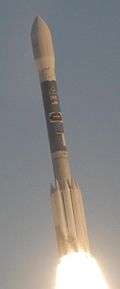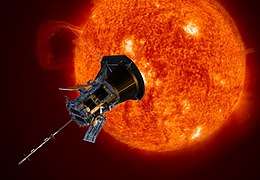Delta IV Heavy
The Delta IV Heavy (Delta 9250H) is an expendable heavy-lift launch vehicle, the largest type of the Delta IV family and the world's second highest-capacity rocket in operation, behind SpaceX's Falcon Heavy rocket.[4][5] It is manufactured by United Launch Alliance and was first launched in 2004.[6]
 Delta IV Heavy launches from Vandenberg AFB | |
| Function | Orbital heavy-lift launch vehicle |
|---|---|
| Manufacturer | United Launch Alliance |
| Country of origin | United States |
| Cost per launch | US$350 million [1] NRO: $440 million |
| Cost per year | 2018 |
| Size | |
| Height | 72 m (236 ft) |
| Diameter | 5 m (16 ft) |
| Width | 15 m (49 ft) |
| Mass | 733,000 kg (1,616,000 lb) |
| Stages | 2+ |
| Capacity | |
| Payload to LEO | 28,790 kg (63,470 lb) |
| Payload to GTO | 14,220 kg (31,350 lb) |
| Associated rockets | |
| Family | Delta IV |
| Comparable | |
| Launch history | |
| Status | Active |
| Launch sites | |
| Total launches | 11 |
| Successes | 10 |
| Partial failures | 1 |
| First flight | 21 December 2004 (USA-181) |
| Last flight | 19 January 2019 (NROL-71) |
| Notable payloads |
|
| Boosters (CBC) | |
| No. boosters | 2 |
| Length | 40.8 m (134 ft) |
| Diameter | 5.1 m (17 ft) |
| Empty mass | 26,000 kg (57,000 lb) |
| Gross mass | 226,400 kg (499,100 lb) |
| Propellant mass | 200,400 kg (441,800 lb) [2] |
| Engines | 1 RS-68A |
| Thrust | 3,140 kN (710,000 lbf) |
| Total thrust | 6,280 kN (1,410,000 lbf) |
| Specific impulse | Sea level: 360 s (3.5 km/s) Vacuum: 412 s (4.04 km/s) |
| Burn time | 242 seconds [3] |
| Fuel | LH2 / LOX |
| First stage (CBC) | |
| Length | 40.8 m (134 ft) |
| Diameter | 5.1 m (17 ft) |
| Gross mass | 226,400 kg (499,100 lb) |
| Propellant mass | 200,400 kg (441,800 lb) |
| Engines | 1 RS-68A |
| Thrust | 3,140 kN (710,000 lbf) |
| Specific impulse | Sea level: 360 s (3.5 km/s) Vacuum: 412 s (4.04 km/s) |
| Burn time | 328 seconds |
| Fuel | LH2 / LOX |
| Second stage (DCSS) | |
| Length | 13.7 m (45 ft) |
| Diameter | 5.1 m (17 ft) |
| Gross mass | 30,700 kg (67,700 lb) |
| Propellant mass | 27,220 kg (60,010 lb) |
| Engines | 1 RL10-B-2 |
| Thrust | 110 kN (25,000 lbf) |
| Specific impulse | 462 s (4.53 km/s) |
| Burn time | 1125 seconds |
| Fuel | LH2 / LOX |
The Delta IV Heavy consists of a central Common Booster Core (CBC), with two additional CBCs as liquid rocket boosters instead of the GEM-60 solid rocket motors used by the Delta IV Medium+ versions. At lift off, all three cores operate at full thrust, and 44 seconds later the center core throttles down to 55% to conserve fuel until booster separation. The boosters burn out at 242 seconds after launch and are separated as the core booster throttles back up to full thrust. The core burns out 86 seconds later, and the second stage completes the ascent to orbit.[3]
The rocket uses 3 RS-68 engines, one in the central core and one in each booster.
History
.jpg)
The Delta IV line of rockets was developed by McDonnell Douglas, later United Launch Alliance. The Delta IV Heavy is the most powerful member of the line, which also includes the smaller Delta IV Medium.[7] The Delta IV Heavy can lift 28,370 kg (62,540 lbs) to low Earth orbit and 13,810 kg (30,440 lbs) to geostationary transfer orbit.[7] It is an all liquid-fueled rocket, consisting of an upper stage, one main booster and two strap-on boosters.[7]
The first launch of the Delta IV Heavy in 2004 carried a boilerplate payload and failed to reach intended orbit. Cavitation in the liquid-oxygen propellant lines caused shutdown of both boosters eight seconds early, and the core engine nine seconds early; this resulted in a lower staging velocity for which the second stage was unable to compensate. The payload was left in a lower than intended orbit.[8] Its first operational payload was the DSP-23 satellite, successfully launched in 2007; it was then used to launch a further five visual and electronic reconnaissance satellites for the National Reconnaissance Office through 2013.
In December 2014, the Delta IV Heavy was used to launch an uncrewed test flight of the Orion spacecraft, designated EFT-1. After several delays on 4 December 2014,[9] the mission was successfully launched at 12:05 UTC on 5 December 2014.[10]
Capability
Capacity of the Delta IV Heavy:
- Low Earth orbit (LEO), 200 km × 28.7°: 28,790 kilograms (63,470 lb) [11]
- Low Earth orbit (ISS), 407 km × 51.6°: 25,980 kilograms (57,280 lb) [12]
- Geosynchronous transfer orbit (GTO): 14,220 kilograms (31,350 lb)[11]
- Geosynchronous orbit (GEO): 6,750 kilograms (14,880 lb) [11]
- Lunar transfer orbit (LTO): 10,000 kilograms (22,000 lb)
- Mars transfer orbit: 8,000 kilograms (17,600 lb)[13]
The Delta IV Heavy's total mass at launch is approximately 733,000 kilograms (1,616,000 lb).
Launch history
| Flight No. | Date | Payload[14] | Mass | Launch site | Outcome[14] |
|---|---|---|---|---|---|
| 1 | 21 December 2004 | DemoSat, Sparkie / 3CS-1 and Ralphie / 3CS-2 | ~6000 kg | Cape Canaveral, SLC-37B | Partial failure[lower-alpha 1] |
| 2 | 11 November 2007 | DSP-23 Defense Support Program | 5250 kg | Cape Canaveral, SLC-37B | Success |
| 3 | 18 January 2009 | Orion 6 / Mentor 4 (USA-202 / NROL-26) | Classified | Cape Canaveral, SLC-37B | Success |
| 4 | 21 November 2010 | Orion 7 / Mentor 5 (USA-223 / NROL-32) | Classified | Cape Canaveral, SLC-37B | Success |
| 5 | 20 January 2011 | KH-11 Kennen 15 (USA-224 / NROL-49) | <17000 kg | Vandenberg, SLC-6 | Success |
| 6 | 29 June 2012 | Orion 8 / Mentor 6 (USA-237 / NROL-15) | Classified | Cape Canaveral, SLC-37B | Success |
| 7 | 28 August 2013 | KH-11 Kennen 16 (USA-245 / NROL-65) | <17000 kg | Vandenberg, SLC-6 | Success |
| 8 | 5 December 2014 | Orion capsule Exploration Flight Test-1 (EFT-1) | 21,000 kilograms (46,000 lb)[15][lower-alpha 2] | Cape Canaveral, SLC-37B | Success |
| 9 | 11 June 2016 | Orion 9 / Mentor 7 (USA-268 / NROL-37) | Classified | Cape Canaveral, SLC-37B | Success |
| 10 | 12 August 2018 | Parker Solar Probe[lower-alpha 3] | 685 kg | Cape Canaveral, SLC-37B | Success |
| 11 | 19 January 2019 | NROL-71 | Classified | Vandenberg, SLC-6 | Success |
Upcoming launches
The following missions have been announced by the National Reconnaissance Office.[16][17] As of August 2020, these are the final five missions.[18]
For these missions including modifications, ULA has been awarded US$2.2 billion, or US$440 million per launch.[19]
| Date (UTC) | Payload | Client | Launch site |
|---|---|---|---|
| 26 August 2020, 05:50 UTC | NROL-44 | NRO | Cape Canaveral, SLC-37B |
| October 2020 | NROL-82 | NRO | Vandenberg, SLC-6 |
| H2 2022 | NROL-91 | NRO | Vandenberg, SLC-6 |
| H2 2022 | NROL-70 | NRO | Cape Canaveral, SLC-37B |
| H2 2023 | NROL-68 | NRO | Cape Canaveral, SLC-37B |
Comparable vehicles
Current:
- Long March 5 (geostationary transfer orbit)
- Long March 5B (low Earth orbit)
- Long March 7A (geostationary transfer orbit)
- Ariane 5
- Falcon Heavy
- Proton-M
Development:
Retired or cancelled:
- Atlas V Heavy (proposed, never developed)
- Saturn IB (retired)
- Titan III (retired)
- Titan IV (retired)
See also
References
- "ULA CEO Tory Bruno". Twitter. Retrieved 12 February 2018.
Delta IV Heavy goes for about $350M. That's current and future, after the retirement of both Delta IV Medium and Delta II.
- "Delta IV Heavy". Spaceflight 101. Retrieved 26 July 2014.
- "Delta IV Payload Planner's Guide, June 2013" (PDF). United Launch Alliance. Archived from the original (PDF) on 10 July 2014. Retrieved 26 July 2014.
- "Mission Status Center". SpaceflightNow. Retrieved 26 July 2014.
The ULA Delta 4-Heavy is currently the world's largest rocket, providing the nation with reliable, proven, heavy lift capability for our country's national security payloads from both the east and west coasts.
- "Falcon Heavy, SpaceX's Big New Rocket, Succeeds in Its First Test Launch". NYTimes. Retrieved 6 February 2018.
The Falcon Heavy is capable of lifting 140,000 pounds to low-Earth orbit, more than any other rocket today.
- "Boeing Delta IV Heavy Achieves Major Test Objectives in First Flight" Archived 2012-04-19 at the Wayback Machine, Boeing, 2004, accessed March 22, 2012.
- "Delta IV Heavy: Powerful Launch Vehicle". Space.com. Retrieved 21 July 2018.
- "Delta 4-Heavy investigation identifies rocket's problem". Spaceflight Now. Retrieved 26 July 2014.
- Bergin, Chris (18 January 2012). "EFT-1 set to receive Spring, 2014 launch date after contract negotiations". NASASpaceFlight.com. Retrieved 21 July 2012.
- "Second Stage Ignites as First Stage Falls Away".
- "Delta IV Launch Services User's Guide" (PDF). United Launch Alliance. 14 October 2013. pp. 2–10, 5–3. Archived from the original (PDF) on 14 October 2013.
- "Delta IV Data Sheet". Space Launch Report. Retrieved 26 July 2014.
- Ray, Justin (7 December 2004). "The Heavy: Triple-sized Delta 4 rocket to debut". Spaceflight Now. Archived from the original on 11 December 2004. Retrieved 13 May 2014.
- Krebs, Gunter. "Delta-4". Gunter's Space Page. Retrieved 15 March 2018.
- "NASA Orion Exploration Flight Test-1 PRESS KIT" (PDF). NASA. December 2014. p. 12.

- Ray, Justin (7 June 2016). "Surveillance satellite launching Thursday atop Delta 4-Heavy rocket". Spaceflight Now.
- http://www.sworld.com.au/steven/space/usmil-man.txt
- Henry, Caleb (21 August 2019). "ULA's Delta 4 Heavy down to final five missions". SpaceNews.
- "Air Force awards ULA $1.18 billion contract to complete five Delta 4 Heavy NRO missions". SpaceNews.com. 30 September 2019. Retrieved 3 June 2020.
_launches_with_LRO_and_LCROSS_cropped.jpg)

